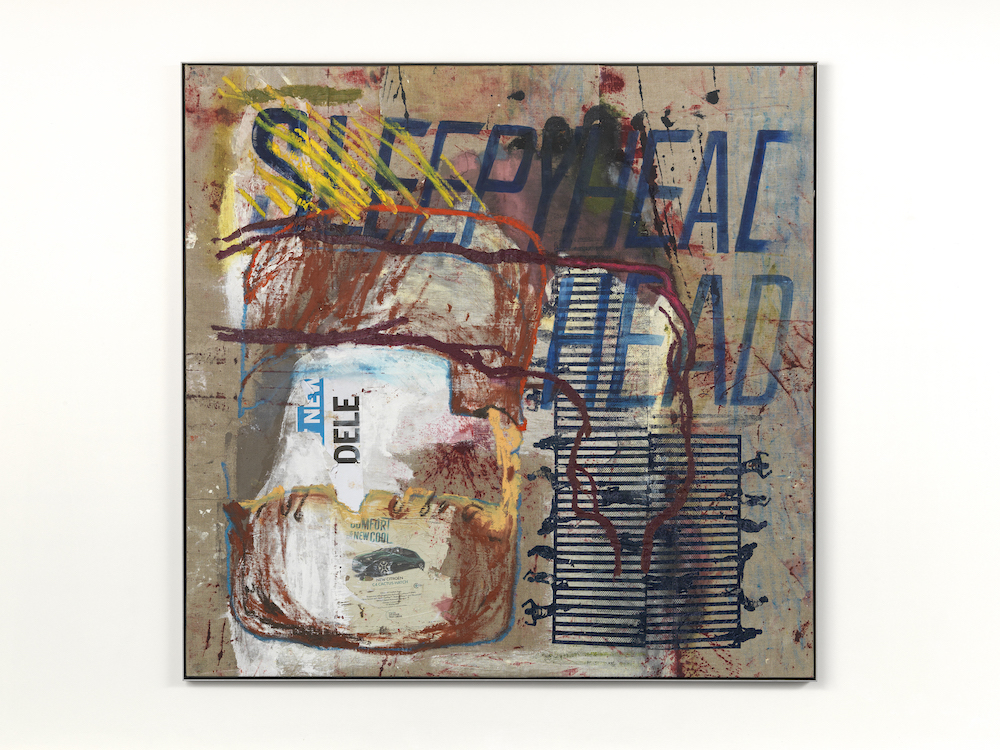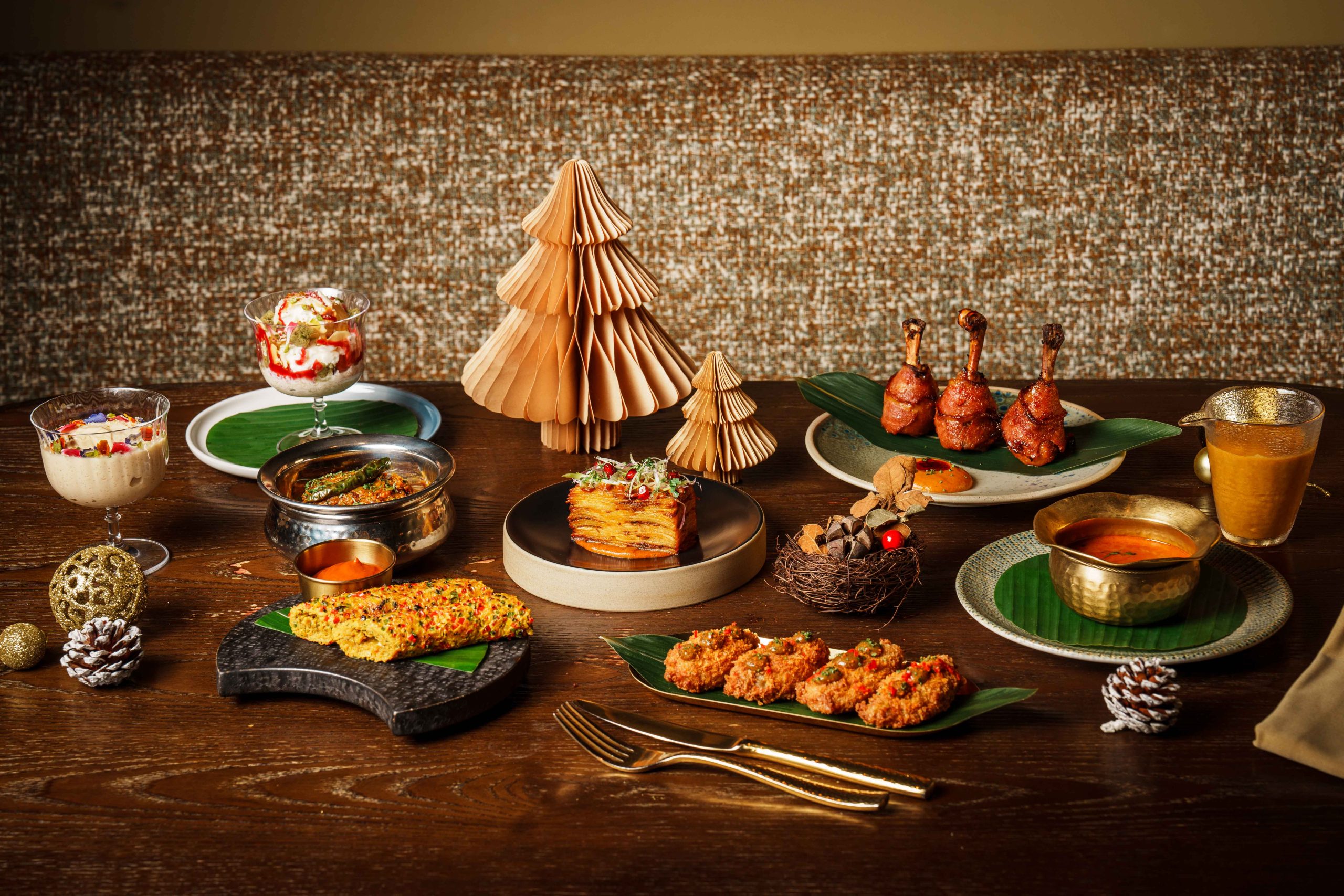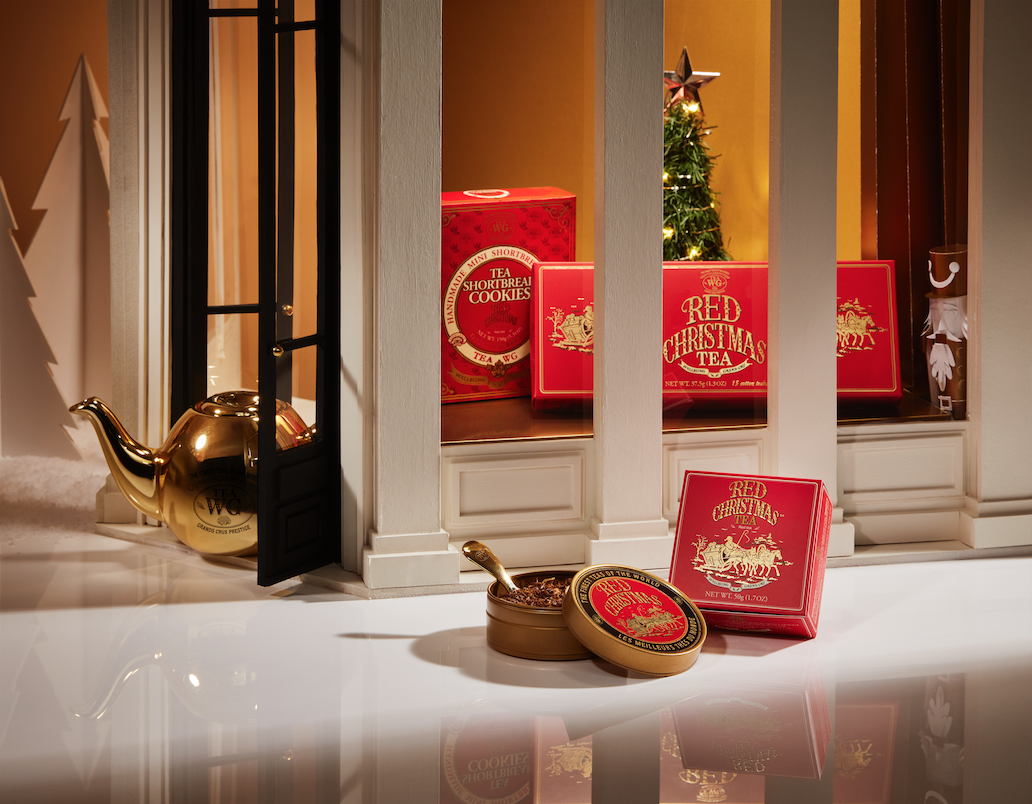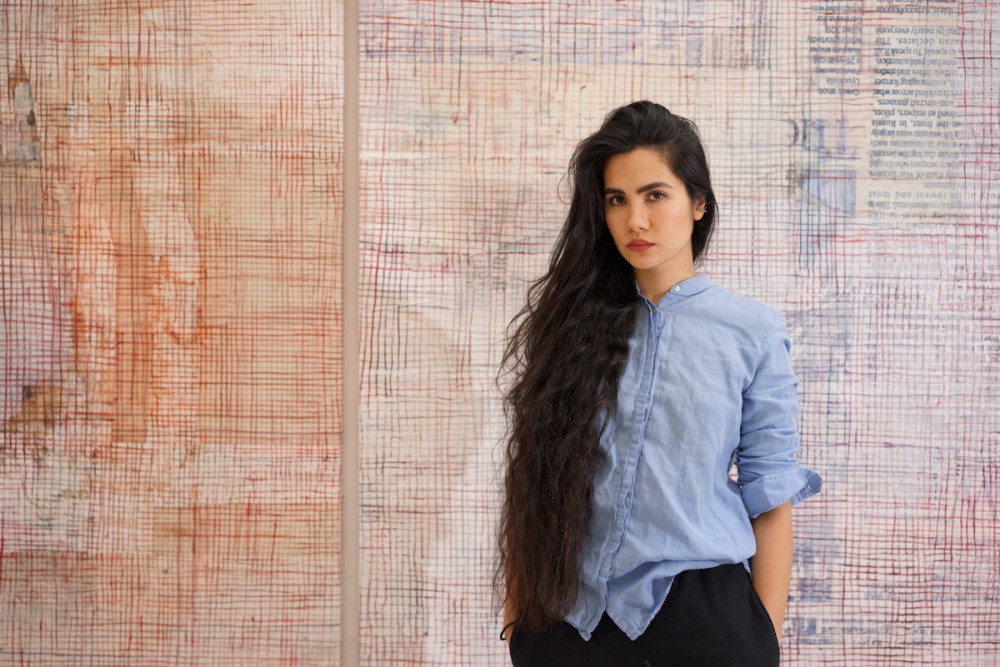
Recently, London-based artist Mandy El-Sayegh launched her first solo exhibition in Asia. Called Dispersal and held at Lehmann Maupin Hong Kong from July 11 to August 23, the exhibition features new paintings, sculpture and installations; these include the Net Grid series, which is a visual recreation of the human process of capturing and retaining information, and the Piece Paintings series, which are silk screenings of various media types that create surrealistic works. Net Grid, notably, makes use of the alla prima (wet-on-wet) painting technique and has latex installation pieces that are laid out on the floor like tiles. The Piece Paintings are positioned in front of walls that are papered with copies of the South China Morning Post that have been glossed over with a white wash. The works themselves draw on a number of themes and relationships between global media, economic systems, history, politics and social media.
Born in Malaysia in 1985, El-Sayegh now lives in London. She received her BFA from the University of Westminster, London in 2007 and her MFA four years later from London’s Royal College of Art. Her other solo exhibitions have been organised in London at the Chisenhale Gallery (2019), Carl Kostyál (2017) and Carlos/Ishikawa (2016), and at The Mistake Room in Guadalajara, Mexico (2018), among others. Group exhibitions and biennales featuring her work have included Ecologies of Darkness at Savvy Contemporary in Berlin (2019) and the Sharjah Biennial 13: Tamawuj in the UAE (2017). We were able to sit down with El-Sayegh to discuss a little bit more about the inspiration behind the show and what different components of the works signify.

Congratulations on your first solo show in Asia. Tell us a little bit more about Dispersal and its influences and inspirations?
I think the whole practise has to do with dealing with the fragment – something that is characterised as not having a context, removed forcibly from its context – and what methods one would employ to deal with that to re-form something. You know, a dispersal of something is not a negative or positive thing, but it makes you think that something has already happened – some kind of explosion or a falling apart of something. For me, on a personal level, it has to do with a feeling of anxiety; I call it a feeling of dispersal of the body. The idea of the show is putting together these fragments and regimes of seeing, like dominant forms, painting, male painting and sculpture. So things aren’t one layer, it’s very classical – classical minds, but they kind of want to hide in all these fragments, like treasure troves of detail.
They’re very specific from my archives and my history. One has silkscreen elements of the Anglo-Zulu War from the 1800s. One has a clipping from my father’s newspaper from Sharjah – so there’s a silkscreen of news from the 1980s and Sharjah, in the United Arab Emirates. It’s talking about like the first nationals in space, the Russian guests in Indian space, and then talks about ghost particles and string theory. There’s poetry in that clipping alone because he’s circled certain bits. But through this kind of process of silkscreening, dealing with the picture plane and putting it in this painting mode, it loses this archival weight. I make these vitrine tables as well, so it’s almost like I’m putting that table vertically, and it changes the whole way of seeing or reading. And I like that people can read this background of the newspaper and go back and forth, pushing this idea of value systems.
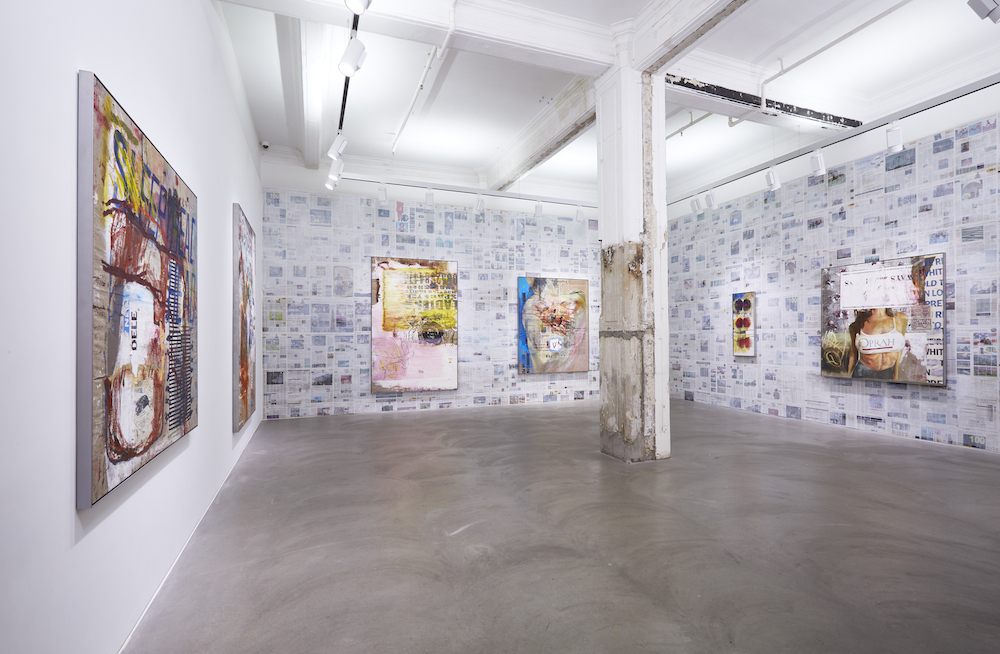
One of the paintings is significantly smaller than the rest; was that deliberate?
All of the works from this room are called Piece Paintings and they’re pieces of what would normally go into a larger hall – which is what I call the Net Grid series, which are always the same size. So that’s just one small piece of the Piece Paintings. I call them that as well because piecework is feminist terminology for unpaid domestic labour or just general unpaid labour. Think about feminine care, repair work – putting together these things that are done on unrecorded time. So it’s a smaller fragment, but essentially they are all the same. Like in one of the larger ones, you can see that there is a suturing here. I could have painted that in a simple way, but I decided to do that instead.
Why did you decide to become an artist?
[laughs] I don’t think anyone decides to. If they decided to, they would be a really bad artist. What I mean by that is that there has to be an element of not choosing to be. You just have to, otherwise you’ll be very depressed. There has to be a certain urgency – because it’s the last thing I wanted to be. [laughs] I’ve always been very creative, but lots of people that are don’t turn out to be artists. For a long time, I thought it wasn’t viable, even though I went to art school. I was employed in social work as a carer of people with learning difficulties and physical ailments. That was a really sad time, because you realise it’s so underfunded by the government, and that if you don’t maintain the body on a consistent level, it goes backward. There’s a maintenance of the body that’s really sad and draining. And so, in a way, not seeing progression in that led me to trying to find a way of escaping that depression.
I mean, in a way, I’d have more integrity if I’d stuck it out. And I know where that comes from, like this raison d’être. I think my whole family has it. My father has it. He has kidney failure and my mother always looked after the whole family. Living with someone with a chronic illness affects the way you see things, so you’re hyper-aware of vulnerability, bodily vulnerability, and the preciousness and precariousness of that. I guess everything’s kind of embodied in the work.
And you can definitely see that in the body parts that are scattered throughout.
Yeah, scattered is a good term.

You mentioned that one of the pieces features your father’s newspaper clippings. For all the pieces, did you go through his archives?
Yeah, and some of them are stolen! [laughs] Because he said to me the other day, “Oh, I can’t find this.” There is a box in the attic that I did go through. But it’s weird because things have this magical, weighted quality if I’ve stolen them or someone has given them to me as a gift. I mentioned the other day that my brother was clearing out his things and I saw his pencil case that he had doodled on during maths – always a boring subject for him, I think – and it was just filled with brain-like forms. And there’s a certain energy imbued in that. If someone has put something away, there’s a reason it’s theirs. They’ve marked it. So that gives it a weight for me – that makes it more valuable than something that’s come from me.
Why use the SCMP as the background?
It’s quite a dumb, simple answer. I always try to use English-speaking translations of a culture or this kind of authoritative idea that may not necessarily always be the case. So, in London, the version would be the Financial Times – I mean, all the papers that you see before you’re boarding a plane. So, if you’re going to China, you’ll see the SCMP. You’ll see this kind of English serif-type font and you’ll see whatever the generic idea of global for that area is – and that in itself is a construction. That’s why I call these the “white-grounds”. Because for painting, you have to create a “white ground” generally for a primary process, but that can mean something conceptually as well as technically. So that [the SCMP] is the version of the “white-ground”.
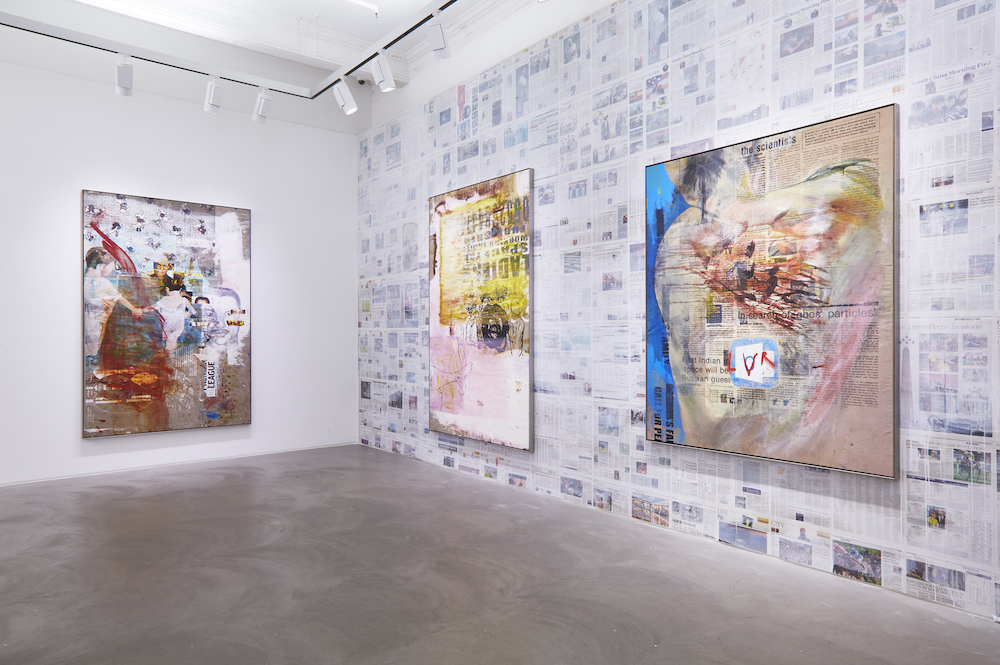
You use English-language newspapers, but is that some Chinese written on one of the paintings?
Yeah, well, I haven’t written it. That’s a silkscreen of a Chinese colouring book that I found in Beijing and someone had scribbled over it. But there is Chinese on the floor [in the Net Grid series room], which is my uncle’s calligraphy from my maternal side, and there’s also Arabic calligraphy, paternal, by my father.
And essentially you wanted to bring this to the forefront?
Yeah, just to kind of centre it. But it’s weird because my context is Western – Western with the heritage of an other. So, mistranslation to me is really important, or slippages between that, and the kind of sense of given authority superimposed on top of all. It’s the same way that you’d be taught to value art through aesthetics and minimalism. There’s a hierarchy of things and craft would be at the bottom. Craft is the feminine, the dirty, the ornamentation. And it’s almost like wanting to bring those things that are suppressed back to the foreground. Obviously in other cultures, they have different histories, but this is a very specific position.
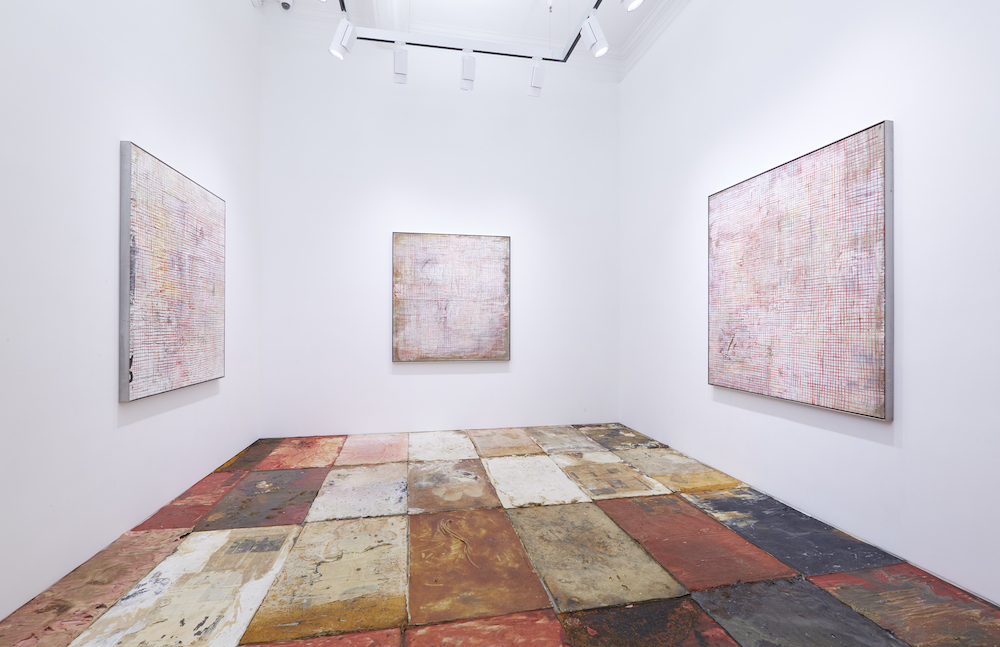
What’s your relationship with social media as an artist?
The relationship isn’t a conscious one. I just use Instagram, I try not to use Facebook if I can help it, I go on YouTube. Just being part of this generation – which is different if you’re from different parts of the world, you know, since we all have different relationships with technology and class that affects that as well – I use it, and then these images appear in the works. So this dumbness is juxtaposed with this weighted political thing. [In one of the Piece Paintings] that’s Emily Ratajkowski’s torso from her Instagram, and this idea of scrolling and screencapping, and this fastness of layering, and the speed of capture and then superimposition, is fascinating. Because you can make your own memes. There’s meme machines, right? [laughs] And you can just capture something and put a really catchy phrase, and that could just go insanely viral.
In a way, I’m sure that’s affecting our neural networks of thinking and speaking. Because there’s something about something that captures a zeitgeist feeling in such a dumb way, but the efficiency of that communication is so much better than any article or any movement. There’s something about that that’s very specific to our time, which has power that shouldn’t be underestimated. I mean, there’s a whole conspiracy theory of how Trump got elected through this meme and they call it “meme magic” [laughs] – the [Pepe the] Frog thing. In a way I think that the visual field in Western culture has been capitalised on really well, always talking about branding, logos, things like that. So it’s a kind of interesting association that is language-based, and you can have that with images or with words. Just putting them next to each other, and if you mess around with that association and put it backwards, it can do something quite different.
How much has living in London or the city itself influenced your work? You spoke about feeling like “the other” in London, but were there instances where you see it as your home, if that’s even the right word to use?
I hear what you’re getting at and it’s weird because it’s both. I feel like a Londoner,, but not as British – it’s quite different. I always complain about London, but it’s the best place ever, because there’s the post-war housing projects in the centre of the city and you get this melting pot of sorts. Whenever I go anywhere else, I’m freaked out. So I’m very lucky and privileged to have that as my norm. That condition of not belonging is allowed there. It kind of heightens it, but you can also accept it. The antagonism is less than if I was in Paris or something, you know. So I think that accepting this position of being in-between informs the work. And it doesn’t even have to be in-between cultures or places; it can even be a middle child in a family, or sexuality. If you are an in-betweener, you can’t be named on either side. I think that’s a good place, because then you’re just naturally questioning everything and not being satisfied with anything. You’re forced to make your own language. See what I mean? [laughs]
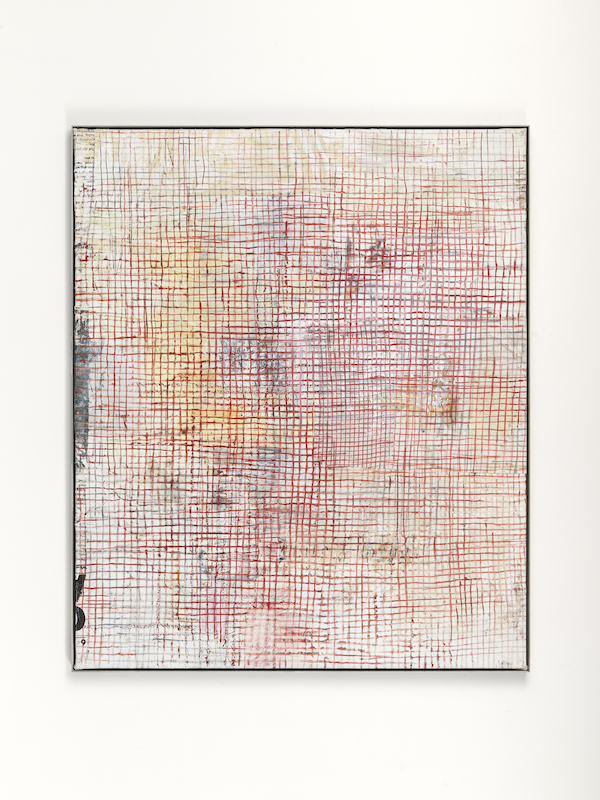
Where do you see yourself in five years? Do you feel like you’ll continue in art, or do you feel like this is more cathartic as opposed to an occupation?
Well, it is an occupation, so I have to keep doing it. Otherwise I won’t have a house to live in! [laughs] But it’s weird, because I don’t think about time in that sense. A lot of my friends are getting pregnant and getting married and stuff. You have to have a timeline for that. I’m thinking like I have to think about kids and if I want them. And I never think like that. So the five-year plan – don’t really have that. I’ll continue doing this as long as I find it engaging for my production of knowledge. If I’m not learning, I’ll get bored and then I won’t do anymore. So I did this from this place of urgency, because something was insufficient for my being. We’re getting really existential here, but it felt like it was getting really repetitive and that things had to change.
In your work, you can see economic influence from the newspaper clippings, and obviously history and the way that the human body is presented. Would you say that this is a sort of exploration of human identity?
It’s not not that. It’s just that I don’t explicitly think from that perspective which is like outside, macro, you know. And in a way, everything’s so specific that it becomes that after. I step back and go, “Oh, I see how that is.” That’s why I’m interested in this zooming in and out, from micro to macro, from the singular to the collective. You just said something I have to write down, that gave me this idea of this shape I want to make. [laughs] Does that answer your question? Because a lot of people ask, “Is your work expressing this?” And sometimes you can only see it after that – in retrospective, retroactively, because you’ve worked from this unconscious stock and it manifests when you can see the patterning after, you know? After the fact. What did you call it? Culture of human identity? [laughs] I just had this image of open human cadavers – I don’t know why! [laughs] Everything I think is very literal to me. So when there are abstract terms like civilisation, I think of something shiny and gold. You know? It’s just this possibility of accessing metaphor, which I think is quite interesting, in a way.
So when you hear “human identity”, what do you think?
I’m thinking open, splayed cadavers, like in a butcher shop. [laughs] I don’t know why. It’s the opposite, because identity is about the construction of meaning in relation to that superimposing to this. Bodies are moving around, right?
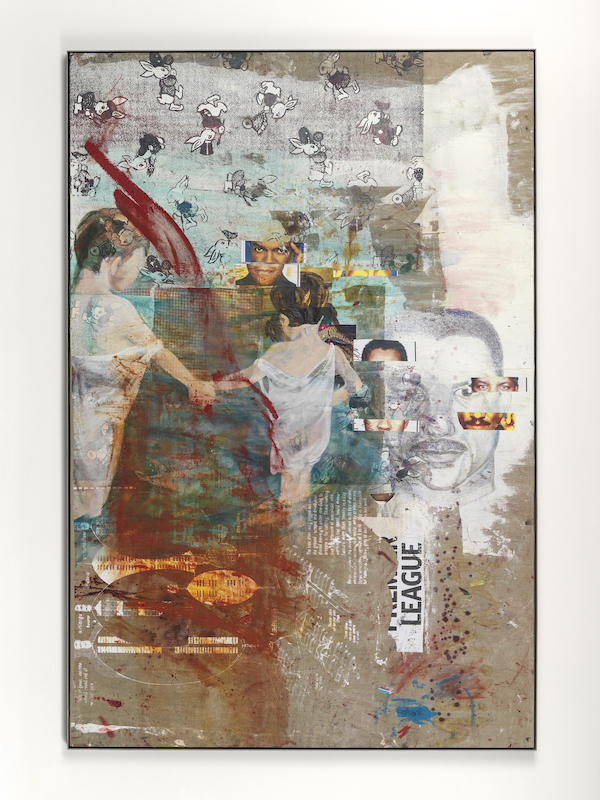
Do you feel like your art could become the voice of a generation? When I see these paintings and the mismatch of everything, going back to the social media question, it’s almost like a feed – as if you were on Instagram and saw everything at the same time.
Thank you! It’s totally, totally like that. Like, in the sense that when people ask about specificity [of what it’s expressing], it’s more to do with that. So the scrolling way of seeing is what informs everything, rather than a specific image. It’s more the way you receive information, rather than the thing you receive, you know what I mean? So, it’s not, “Oh, I think I’m the voice of a generation!” – that’s pretty big to think of. It’s just that we are in this generation, so it is a voice of this generation. But I’m not speaking for anyone else – if people resonate, that’s great.
What’s the one message or feeling or emotion that you want people to take away when they leave? When they’re thinking back from 10 years in the future, what’s the one thing you want them to remember about Dispersal?
Sounds really grandiose [laughs] but what I want isn’t really what will happen, so it seems really unrealistic. But I can say what I’m exploring as my themes, and whether that is received or not. Is that realistic? [laughs] So how the fragment can re-form, in the sense that I’m always working on the sense of anxiety and what to do with that anxiety. What to do with the too much-ness of things – this over-visibility of the body and the under-representation of histories and subjects. But you know, when you walk into the show, you might not necessarily get that, so that’s a big ask. But those are the things I’m exploring.
